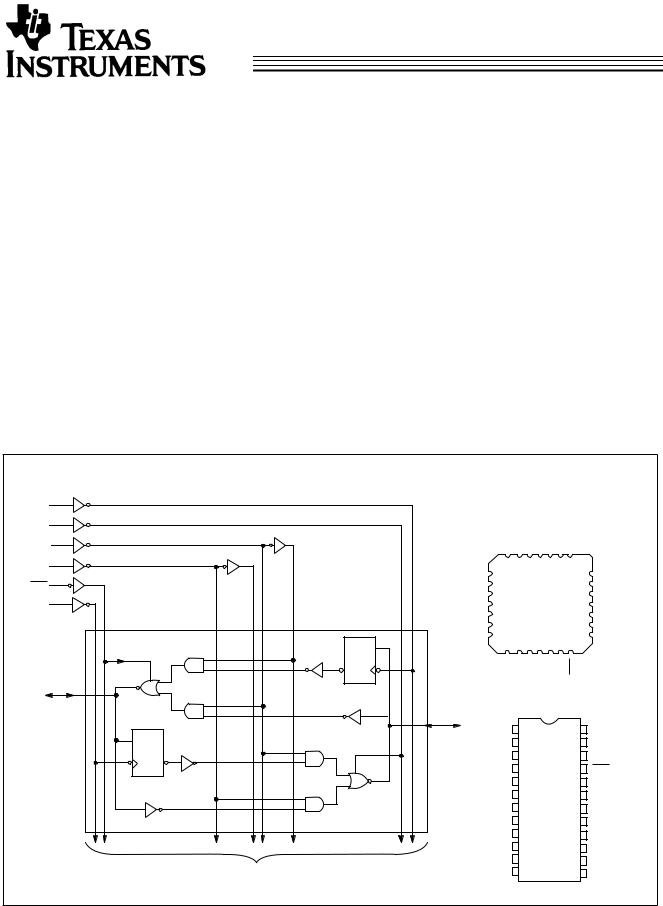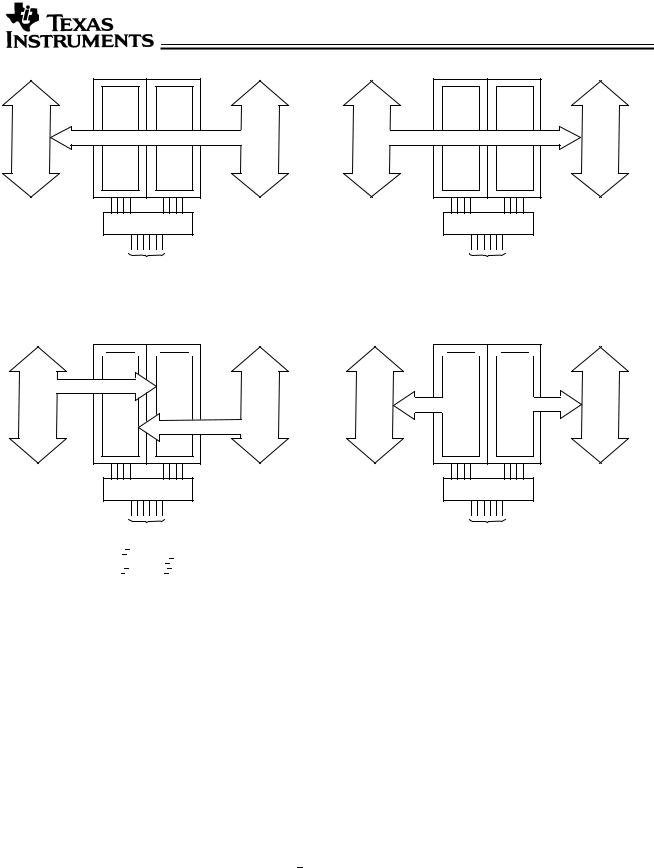Texas Instruments CY74FCT652TQCT, CY74FCT652TQC, CY74FCT652CTSOCT, CY74FCT652CTSOC, CY74FCT652CTQCT Datasheet
...
Data sheet acquired from Cypress Semiconductor Corporation.
Data sheet modified to remove devices not offered.
CY74FCT652T
SCCS032 - September 1994 - Revised March 2000
8-Bit Registered Transceiver
Features
•Function, pinout, and drive compatible with FCT and F logic
•FCT-C speed at 5.4 ns max. (Com’l)
FCT-A speed at 6.3 ns max. (Com’l)
• Reduced V (typically = 3.3V) versions of equivalent
OH
FCT functions
•Edge-rate control circuitry for significantly improved noise characteristics
•Power-off disable feature
•Matched rise and fall times
•Fully compatible with TTL input and output logic levels
• Sink Current |
64 mA |
Source Current |
32 mA |
•Independent register for A and B buses
•Multiplexed real-time and stored data transfer
•Extended commercial range of−40˚C to +85˚C
Functional Description
The FCT652T consists of bus transceiver circuits, D-type flip-flops, and control circuitry arranged for multiplexed transmission of data directly from the input bus or from the internal storage registers. GAB and GBA control pins are provided to control the transceiver functions. SAB and SBA control pins are provided to select either real-time or stored data transfer. The circuitry used for select control will eliminate the typical decoding glitch that occurs in a multiplexer during the transition between stored and real-time data. A LOW input level selects real-time data and a HIGH selects stored data.
Data on the A or B data bus, or both, can be stored in the internal D flip-flops by LOW-to-HIGH transitions at the appropriate clock pins (CPAB or CPBA), regardless of the select or enable control pins. When SAB and SBA are in the real-time transfer mode, it is also possible to store data without using the internal D-type flip-flops by simultaneously enabling GAB and GBA. In this configuration, each output reinforces its input. Thus, when all other data sources to the two sets of bus lines are at high impedance, each set of bus lines will remain at its last state.
The outputs are designed with a power-off disable feature to allow for live insertion of boards.
Logic Block Diagram |
|
Pin Configurations |
|
|||||||
CPBA |
|
|
|
|
LCC |
|
|
|
||
|
|
|
|
|
|
|
|
|||
GAB |
|
|
|
Top View |
|
|||||
SBA |
|
|
6 |
5 |
4 |
NC |
3 2 1 |
|
||
|
|
A |
A |
A |
A A A |
|
||||
SAB |
|
|
11 10 9 |
8 |
7 |
6 |
5 |
|
||
|
|
A7 |
12 |
|
|
|
|
|
4 |
GAB |
GBA |
|
A8 |
13 |
|
|
|
|
|
3 |
SAB |
CPAB |
|
GND |
14 |
|
|
|
|
|
2 |
CPAB |
|
NC |
15 |
|
|
|
|
|
1 |
NC |
|
|
B REG |
B8 |
16 |
|
|
|
|
|
28 |
VCC |
|
B7 |
17 |
|
|
|
|
|
27 |
CPBA |
|
|
|
|
|
|
|
|
||||
|
|
B6 |
18 |
|
|
|
|
|
26 |
SBA |
1 OF 8 CHANNELS |
|
|
|
|
|
|
|
|||
D |
|
19 20 21 22 2324 25 |
|
|||||||
|
|
|
|
|
|
|
|
|
|
|
|
|
|
5 |
4 3 |
NC |
2 1 |
GBA |
|
||
|
C |
|
B |
B |
B |
B B |
|
|||
A1 |
|
|
|
SOIC/QSOP |
|
|||||
|
|
|
|
|
Top View |
|
||||
A REG |
|
B1 |
|
|
|
|
|
|
|
|
|
|
CPAB |
1 |
|
|
|
24 |
VCC |
||
|
|
|
|
|
|
|||||
D |
|
|
SAB |
2 |
|
|
|
23 |
CPBA |
|
C |
|
|
GAB |
3 |
|
|
|
22 |
SBA |
|
|
|
A1 |
4 |
|
|
|
21 |
GBA |
||
|
|
|
|
|
|
|||||
|
|
|
A2 |
5 |
|
|
|
20 |
B1 |
|
|
|
|
A3 |
6 |
|
|
|
19 |
B2 |
|
|
|
|
A4 |
7 |
|
|
|
18 |
B3 |
|
|
|
|
A5 |
8 |
|
|
|
17 |
B4 |
|
|
|
|
A6 |
9 |
|
|
|
16 |
B5 |
|
|
|
|
A7 |
10 |
|
|
|
15 |
B6 |
|
|
|
|
A8 |
11 |
|
|
|
14 |
B7 |
|
|
TO 7 OTHER CHANNELS |
|
GND |
12 |
|
|
|
13 |
B8 |
|
|
|
|
|
|
|
|||||
Copyright © 2000, Texas Instruments Incorporated

CY74FCT652T
BUS A |
BUS B |
BUS A |
BUS B |
GAB |
|
|
|
|
|
|
|
|
|
|
|
|
|
|
|
|
GAB |
|
|
|
|
|
|
|
|
|
|
|
|
|
|
|
|
|
GBA |
|
|
|
CPAB |
|
|
|
CPBA |
SAB |
SBA |
GBA |
|
|
|
CPAB |
|
|
CPBA |
SAB |
SBA |
||||||||||||||
L |
L |
|
|
|
X |
|
|
|
X |
X |
L |
H |
H |
|
|
|
X |
|
|
|
X |
L |
X |
|||||||||||
|
|
Real-Time Transfer |
|
|
|
|
|
Real-Time Transfer |
|
|
||||||||||||||||||||||||
|
|
|
|
|
Bus B to Bus A |
|
|
|
|
|
|
|
|
Bus A to Bus B |
|
|
||||||||||||||||||
|
|
|
|
|
|
|
|
|
|
|
|
|
|
|
|
|
|
|
|
|
|
|
|
|
|
|
|
|
|
|
|
|
|
|
BUS A |
BUS B |
BUS A |
BUS B |
GAB |
|
|
|
|
|
|
|
|
GAB |
|
|
|
|
|
|
|
GBA |
CPAB |
CPBA |
SAB |
SBA |
GBA |
CPAB |
CPBA |
SAB |
SBA |
|||||
X |
|
H |
|
|
X |
X |
X |
H |
L |
H or L |
H or L |
H |
H |
||
|
|
|
|||||||||||||
L |
|
X |
X |
|
|
X |
X |
|
|
|
|
|
|
|
|
|
|
|
|
|
|
|
|
|
|
||||||
L |
|
H |
|
|
|
|
X |
X |
|
Transferred Stored Data |
|
||||
|
|
|
|
|
|
|
|||||||||
|
|
|
|
|
|
|
|
|
|
|
|||||
|
Store Data from A and/or B |
|
|
|
|
to A and/or B |
|
|
|||||||
Function Table[1]
|
|
|
|
|
|
|
Inputs |
|
|
Data I/O |
|
|||||
|
|
|
|
|
|
|
|
|
|
|
|
|
|
|
|
|
GAB |
|
|
|
CPAB |
CPBA |
SAB |
SBA |
A1 thru A8 |
B1 thru B8 |
Operation or Function |
||||||
GBA |
||||||||||||||||
L |
|
H |
|
H or L |
H or L |
X |
X |
Input |
Input |
Isolation |
||||||
L |
|
H |
|
|
|
|
|
|
|
|
|
X |
X |
|
|
Store A and B Data |
|
|
|
|
|
|
|
|
|
|
|
|
|||||
|
|
|
|
|
|
|
|
|
|
|
|
|||||
|
|
|
|
|
|
|
|
|
|
|
|
|
|
|
|
|
X |
|
H |
|
|
|
|
|
H or L |
X |
X |
Input |
Unspecified[2] |
Store A, Hold B |
|||
|
|
|
|
|
|
|||||||||||
H |
|
H |
|
|
|
|
|
|
|
|
|
X[1] |
X |
Input |
Output |
Store A in both registers |
|
|
|
|
|
|
|
|
|
|
|||||||
|
|
|
|
|
|
|
|
|
|
|||||||
L |
|
X |
|
H or L |
|
|
|
|
X |
X |
Unspecified[2] |
Input |
Hold A, Store B |
|||
|
|
|
|
|
|
|||||||||||
L |
|
L |
|
|
|
|
|
|
|
|
|
X |
X[1] |
Output |
Input |
Store B in both registers |
|
|
|
|
|
|
|
|
|
|
|||||||
|
|
|
|
|
|
|
|
|
|
|||||||
L |
|
L |
|
|
X |
|
X |
X |
L |
Output |
Input |
Real-Time B Data to A Bus |
||||
L |
|
L |
|
|
X |
H or L |
X |
H |
|
|
Stored B Data to A Bus |
|||||
|
|
|
|
|
|
|
|
|
|
|
|
|
|
|
|
|
H |
|
H |
|
|
X |
|
X |
L |
X |
Input |
Output |
Real-Time A Data to B Bus |
||||
H |
|
H |
|
H or L |
|
X |
H |
X |
|
|
Stored A Data to B Bus |
|||||
|
|
|
|
|
|
|
|
|
|
|
|
|
|
|
|
|
H |
|
L |
|
H or L |
H or L |
H |
H |
Output |
Output |
Stored A Data to B Bus |
||||||
|
|
|
|
|
|
|
|
|
|
|
|
|
|
|
|
and Stored B Data to A Bus |
|
|
|
|
|
|
|
|
|
|
|
|
|
|
|
|
|
Notes:
1.Select control=L: clocks can occur simultaneously. Select control=H: clocks must be staggered in order to load both registers. H = HIGH Voltage Level. L = LOW Voltage Level. X = Don’t Care.  = LOW-to-HIGH Transition.
= LOW-to-HIGH Transition.
2.The data output functions may be enabled or disabled by various signals at the GAB or GBA inputs. Data input functions are always enabled, i.e., data at the bus pins will be stored on every LOW-to-HIGH transition on the clock inputs.
2

CY74FCT652T
Maximum Ratings[3, 4]
(Above which the useful life may be impaired. For user guidelines, not tested.)
Storage Temperature ................................. |
–65°C to +150°C |
Ambient Temperature with |
–65°C to +135°C |
Power Applied ............................................. |
|
Supply Voltage to Ground Potential ............... |
–0.5V to +7.0V |
DC Input Voltage............................................ |
–0.5V to +7.0V |
DC Output Voltage ......................................... |
–0.5V to +7.0V |
DC Output Current (Maximum Sink Current/Pin) ...... |
120 mA |
Power Dissipation .......................................................... |
0.5W |
Static Discharge Voltage............................................ |
>2001V |
(per MIL-STD-883, Method 3015)
Operating Range
|
|
Ambient |
|
Range |
Range |
Temperature |
VCC |
Commercial |
T, AT, CT |
–40°C to +85°C |
5V ± 5% |
|
|
|
|
Electrical Characteristics Over the Operating Range
|
Parameter |
Description |
|
Test Conditions |
Min. |
Typ.[5] |
Max. |
Unit |
||
VOH |
Output HIGH Voltage |
VCC=Min., IOH=–32 mA |
2.0 |
|
|
V |
||||
|
|
|
VCC=Min., IOH=–15 mA |
2.4 |
3.3 |
|
V |
|||
VOL |
Output LOW Voltage |
VCC=Min., IOL=64 mA |
|
0.3 |
0.55 |
V |
||||
VIH |
Input HIGH Voltage |
|
|
|
|
2.0 |
|
|
V |
|
VIL |
Input LOW Voltage |
|
|
|
|
|
|
0.8 |
V |
|
VH |
Hysteresis[6] |
All inputs |
|
|
|
0.2 |
|
V |
||
VIK |
Input Clamp Diode Voltage |
VCC=Min., IIN=–18 mA |
|
–0.7 |
–1.2 |
V |
||||
II |
Input HIGH Current |
VCC=Max., VIN=VCC |
|
|
5 |
A |
||||
I |
IH |
Input HIGH Current[6] |
V |
=Max., V |
IN |
=2.7V |
|
|
±1 |
A |
|
|
CC |
|
|
|
|
|
|
||
I |
IL |
Input LOW Current[6] |
V |
=Max., V |
IN |
=0.5V |
|
|
±1 |
A |
|
|
CC |
|
|
|
|
|
|
||
IOZH |
Off State HIGH-Level |
VCC=Max., VOUT=2.7V |
|
|
10 |
A |
||||
|
|
Output Current |
|
|
|
|
|
|
|
|
|
|
|
|
|
|
|
||||
IOZL |
Off State LOW-Level |
VCC=Max., VOUT=0.5V |
|
|
–10 |
A |
||||
|
|
Output Current |
|
|
|
|
|
|
|
|
|
|
|
|
|
|
|
|
|
|
|
I |
OS |
Output Short Circuit Current[7] |
V |
=Max., V |
|
=0.0V |
–60 |
–120 |
–225 |
mA |
|
|
CC |
OUT |
|
|
|
|
|||
IOFF |
Power-Off Disable |
VCC=0V, VOUT=4.5V |
|
|
±1 |
A |
||||
Capacitance[6]
Parameter |
Description |
Typ.[5] |
Max. |
Unit |
CIN |
Input Capacitance |
5 |
10 |
pF |
COUT |
Output Capacitance |
9 |
12 |
pF |
Notes: |
|
|
|
|
3.Unless otherwise noted, these limits are over the operating free-air temperature range.
4.Unused inputs must always be connected to an appropriate logic voltage level, preferably either VCC or ground.
5.Typical values are at VCC=5.0V, TA=+25˚C ambient.
6.This parameter is specified but not tested.
7.Not more than one output should be shorted at a time. Duration of short should not exceed one second. The use of high-speed test apparatus and/or sample and hold techniques are preferable in order to minimize internal chip heating and more accurately reflect operational values. Otherwise prolonged shorting of a high output may raise the chip temperature well above normal and thereby cause invalid readings in other parametric tests. In any sequence of parameter tests, IOS tests should be performed last.
3
